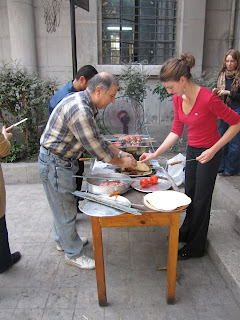When I taste and smell these meatballs, I am whisked back across the Atlantic, where I am eating from gold plates on richly brocaded tables, served with unrivaled hospitality, and presented with endless plates of aromas and flavors that make each meal a sensual experience.
Aleppan cuisine is renowned throughout the Middle East for its rich flavors that result from the blending of Turkish, Armenian, Arab, and Jewish influences. After experiencing it for the first time in restaurants in the Arab world, I devoured all I could and knew that when I came home, replicating it would become a consuming passion. Fortunately, Poopa Dweck made my quest easier with her gorgeous cookbook and coffee-table book, Aromas of Aleppo, from which this recipe is heavily adapted.

One hallmark of Aleppan cuisine is its use of the tamarind, a pod-vegetable which is treated as a fruit, and which is also common in Indian cuisine. Tamarind is used as a digestive aid throughout the Middle East and South Asia, perhaps because 1 tablespoon of tamarind concentrate contains approximately 3 grams of dietary fiber. Tamarind is also rich in anti-oxidants. Many other health claims have been made about tamarind. Look for tamarind concentrate in Middle Eastern or Indian groceries. Tamarind is rich and naturally tart; add sugar or agave as you like to sweeten it.
Another distinct feature is Aleppo pepper, a mild pepper which grows exclusively in the Levant and Turkey. I find Aleppo pepper at the Armenian groceries in Watertown, MA such as Arax.
I used beef to make these meatballs because that was what I had in the freezer, but bison or a half-beef, half-turkey combination would have worked nicely and would have been a healthier choice. Turkey meatballs would also have worked with the addition of a minced onion to prevent the meat from drying out.
Total Time: 60 minutes
Work Time: 30 minutes
Serves: 4, with rice to soak up the exquisite sauce
Meatballs:
1 pound ground beef (or substitutions, per above)
3 eggs, or 1 egg and 3-4 egg whites, beaten
3 T fresh bread crumbs
1 t Aleppo pepper or 1/2 t crushed red pepper
1.5 T kosher salt or coarse sea salt
2 T pine nuts or walnuts, minced
2 handfuls parsley, minced
(tip: whir the last 3 ingredients in a food processor together to prepare)
Sauce:
1 6 ounce can tomato paste
1 T tamarind paste (also called tamarind concentrate)
Juice of 1 lemon
1 t kosher salt or coarse sea salt
1/2 t sugar or 1/4 t agave, possibly more to taste
1. Preheat oven to 350 degrees.
2. Combine all meatball ingredients. Shape into walnut-sized balls and place on a lightly-oiled baking tray. Bake for 30 minutes.
3. Meanwhile, in a medium-sized bowl, whisk together all sauce ingredients.
4. Transfer meatballs to a saucepan and cover with the sauce. Simmer 15-30 minutes, until sauce thickens, flavors blend, and aromas entice you.
 Tamarind
Tamarind

Images of tamarind pods used with permission under the Creative Commons license by Clemens PFEIFFER, 1190 Wien. Image of Aleppo pepper used with permission pursuant to the Creative Commons license. All other photos copyright 2010, Smart Green Gourmet.
































